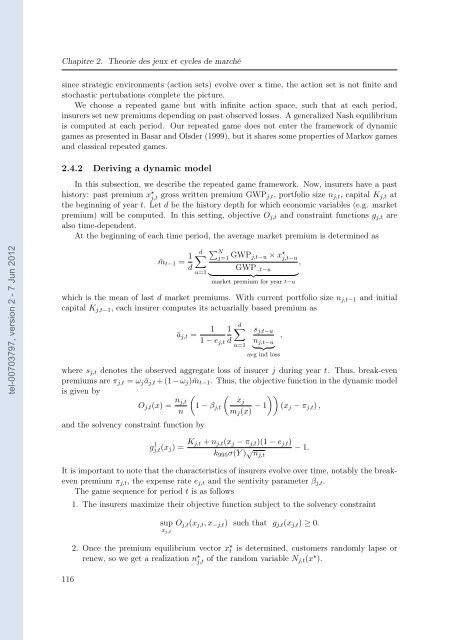Etude des marchés d'assurance non-vie à l'aide d'équilibres de ...
Etude des marchés d'assurance non-vie à l'aide d'équilibres de ...
Etude des marchés d'assurance non-vie à l'aide d'équilibres de ...
You also want an ePaper? Increase the reach of your titles
YUMPU automatically turns print PDFs into web optimized ePapers that Google loves.
tel-00703797, version 2 - 7 Jun 2012<br />
Chapitre 2. Theorie <strong><strong>de</strong>s</strong> jeux et cycles <strong>de</strong> marché<br />
since strategic environments (action sets) evolve over a time, the action set is not finite and<br />
stochastic pertubations complete the picture.<br />
We choose a repeated game but with infinite action space, such that at each period,<br />
insurers set new premiums <strong>de</strong>pending on past observed losses. A generalized Nash equilibrium<br />
is computed at each period. Our repeated game does not enter the framework of dynamic<br />
games as presented in Basar and Ols<strong>de</strong>r (1999), but it shares some properties of Markov games<br />
and classical repeated games.<br />
2.4.2 Deriving a dynamic mo<strong>de</strong>l<br />
In this subsection, we <strong><strong>de</strong>s</strong>cribe the repeated game framework. Now, insurers have a past<br />
history: past premium x ⋆ j,t gross written premium GWPj,t, portfolio size nj,t, capital Kj,t at<br />
the beginning of year t. Let d be the history <strong>de</strong>pth for which economic variables (e.g. market<br />
premium) will be computed. In this setting, objective Oj,t and constraint functions gj,t are<br />
also time-<strong>de</strong>pen<strong>de</strong>nt.<br />
At the beginning of each time period, the average market premium is <strong>de</strong>termined as<br />
¯mt−1 = 1<br />
d<br />
d<br />
u=1<br />
N j=1 GWPj,t−u × x⋆ j,t−u<br />
<br />
GWP.,t−u<br />
<br />
,<br />
<br />
market premium for year t−u<br />
which is the mean of last d market premiums. With current portfolio size nj,t−1 and initial<br />
capital Kj,t−1, each insurer computes its actuarially based premium as<br />
1 1<br />
āj,t =<br />
1 − ej,t d<br />
d sj,t−u<br />
nj,t−u<br />
<br />
,<br />
avg ind loss<br />
where sj,t <strong>de</strong>notes the observed aggregate loss of insurer j during year t. Thus, break-even<br />
premiums are πj,t = ωjāj,t + (1 − ωj) ¯mt−1. Thus, the objective function in the dynamic mo<strong>de</strong>l<br />
is given by<br />
Oj,t(x) = nj,t<br />
n<br />
and the solvency constraint function by<br />
u=1<br />
<br />
xj<br />
1 − βj,t − 1 (xj − πj,t) ,<br />
mj(x)<br />
g 1 j,t(xj) = Kj,t + nj,t(xj − πj,t)(1 − ej,t)<br />
k995σ(Y ) √ nj,t<br />
It is important to note that the characteristics of insurers evolve over time, notably the breakeven<br />
premium πj,t, the expense rate ej,t and the sentivity parameter βj,t.<br />
The game sequence for period t is as follows<br />
116<br />
1. The insurers maximize their objective function subject to the solvency constraint<br />
sup<br />
xj,t<br />
− 1.<br />
Oj,t(xj,t, x−j,t) such that gj,t(xj,t) ≥ 0.<br />
2. Once the premium equilibrium vector x ⋆ t is <strong>de</strong>termined, customers randomly lapse or<br />
renew, so we get a realization n ⋆ j,t of the random variable Nj,t(x ⋆ ).
















